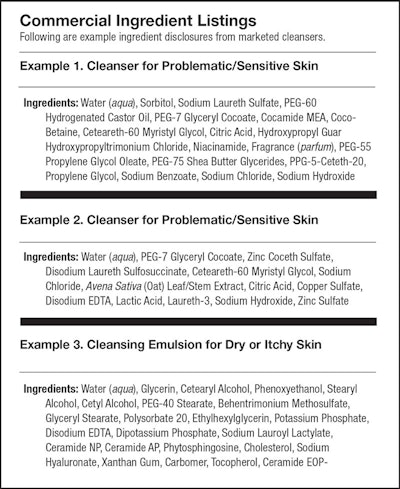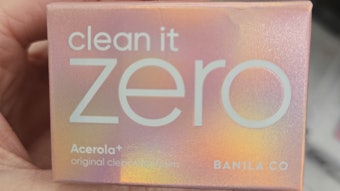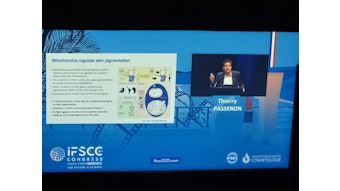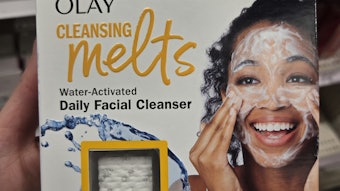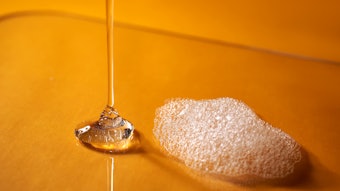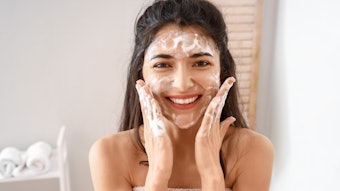
Additive Effects
Besides surfactant combinations, another approach to stabilizing surfactant micelles is to add polymers to the formulation, such as hydrophobically modified polymers (HMPs). HMPs have multiple hydrophobic groups that bind to surfactants at their hydrophobic tails. Through these contacts, HMPs stabilize the micelle core and increase its size. HMPs also can improve foaming by stabilizing the air-water interface of bubbles.23
Additional studies have lead to the inclusion of high levels of emollients (20-50%), such as petrolatum or triglycerides, to formulas; see Formula 2 and Formula 3. This is because emollients were found to improve the mildness and moisturization of cleansers. In particular, bodywashes containing about 20% triglyceride oils were shown in vivo to deposit approximately 10 µg cm−2 of triglycerides onto skin during washing.24 Thus, the adequate use of a “traditional” formulation could impart good results in terms of mildness (see Figure 2).
Finally, the use of acrylates copolymer in a cleanser might improve skin discomfort after washing, thanks to its ability to reduce friction between the skin and clothing.25
Skin Treatment
Skin cleansing is often viewed as the starting point of any skin care treatment. Indeed, cleansing products often state claims very similar to those of leave-on skin care formulae. Shampoo systems exist from which the deposition of conditioning materials such as silicone oils onto hair is achieved by means of polymers; e.g., polysaccharides, quaternary, acrylates copolymer, etc. Inspired by these technologies, the same polymers can enable skin treatment during the rinsing phase by the deposition and delivery of emollients, moisturizers and functional ingredients.
In spite of the frequent and abundant use of cleansers, the fine mechanisms taking place during skin cleansing are still largely unknown.
Typically, the most-used polymers are polyquaternium grade (P-10, P-7);26 acrylates copolymer;23 polysaccharides (hyaluronic acid, Opuntia ficus indica, Tamarindus extract, etc.);27 and/or their combination—along with a broad list of active ingredients such as vitamins (niacinamide, tocopherol, etc.); ceramides, humectants (glycerin, urea, etc.); re-epithelizing agents (panthenol, aloe vera, etc.); or trace elements including copper, zinc, manganese, etc., with antibacterial efficacy. Examples 1 and 2 in the Commercial Ingredient Listings sidebar provide sample INCI listings of products marketed for sensitive or problematic skin. Quite evident in both formulae is the combination of different types of surfactants and polymers, in order to reduce the aggressive action of the product; and polysaccharides polysaccharide derivates from vegetal origin; plus active ingredients such as vitamins, humectants and trace elements.
Taking a more extreme approach, some brands have started to formulate very mild products using nonfoaming formulas—similar in structure to the emulsions used as makeup removers or hair conditioners. These formulas can effectively cleanse and hydrate without affecting the skin barrier simply based on the solvent properties of the oil phase and the washing characteristics of high-polarity emulsifiers (see Commercial Ingredient Listings sidebar, Example 3). Also, in this case, the introduction of acrylates copolymer and quaternary compounds enhances the adhesion of the actives onto the skin.
Tolerability Evaluation
Evaluating the mildness of formulated products after their development is, clearly, also very important. Similar to sunscreens, the mildness claims of these products must be verified in vivo using the correct testing protocols, in order to avoid serious damage to the most sensitive consumers. Simply using consumer self-evaluations, as is often claimed, is not enough. Indeed, it is strongly recommended that the subsequent combination of primary tolerability tests—a patch test (48 hr or 72 hr) followed by repeated arm wash tests28, 29—should be carried out, when possible, on volunteers with sensitive skin, together with long-term “n-use” tests under dermatologist control.
Conclusion
In spite of the frequent and abundant use of cleansing products, the fine mechanisms taking place during skin cleansing are still largely unknown. The chemistry and structure of surfactants play a major role, as do their association phenomena in solution and their behavior when diluted and massaged onto the skin. Moreover, their ease of rinsing and the complete release of traces of surfactant residual within skin wrinkles are also key factors, associated with water hardness and temperature.
The short length of time cleansing surfactants are in contact with skin is only partly apparent; residues in concentrated form can remain for hours on the skin surface and have the potential to disrupt the barrier in the interval between washes. Since the cleansing process is a multistage event, wherein the elimination of skin surface materials cannot easily be controlled without some type of impairment to the assembly of skin lipids beneath, studies are still required to understand this complex phenomenon and the distribution of molecules on the different levels of skin layers.
References
- Hay, R. J., et al. (2014). The global burden of skin disease in 2010: An analysis of the prevalence and impact of skin conditions, J Invest Dermatol 134, 1527-1534.
- Segre, J. A. (2006). Epidermal barrier formation and recovery in skin disorders, J Clin Invest 116, 1150-1158
- Lynch, P. J., (1994). Dermatology, House Officer Series. Philadelphia: Williams & Wilkins.
- Nutten, S., (2015). Atopic dermatitis: Global epidemiology and risk factors, Ann Nutr Metab 66(suppl 1), 8-16.
- Lim, H. W., et al. (2017). The burden of skin disease in the United States, JAAD 75(5), 958-972.
- Ballanger, F., et al. (2006). Heredity: A prognostic factor for acne, Dermatology 212, pp. 145-149.
- Lee, C.H., et al. (2006). Transepidermal water loss, serum IgE and beta-endorphin as important and independent biological markers for development of itch intensity in atopic dermatitis, Br J Dermatol 154, pp. 1100-1107
- Mehling, A., Kleber, M. & Hensen, H. (2007). Comparative studies on the ocular and dermal irritation potential of surfactants, Food and Chemical Toxicology 45, pp. 747-758.
- Rhein, L.D., et al., (1986). Surfactant structure effects on swelling of isolated human stratum corneum, J Soc Cosmet Chem 37, pp. 125.
- Rieger, M.M. (1995). Surfactant interactions with skin, Cosm & Toil 110(4), pp. 31-50.
- Rhein, L.D., (1997). Review of properties of surfactants that determine their interaction with stratum corneum, J Soc Cosmet Chem 48, pp. 253-274.
- Lansdown, A.B.G. & Grasso, P., (1972). Physico-chemical factors influencing epidermal damage by surface active agents, Br J Dermatol 86, pp. 361-378.
- Effendy, I., & Maibach, H. I. (1995). Surfactants and experimental irritant contact dermatitis, Contact Dermatitis 33, 217-225.
- Walters, K. A., Bialik, W., & Brain, K. R. (1993). The effects of surfactants on penetration across the skin, Int J Cosmet Sci 15, 260-271.
- Corazza, M., et al. (2010). Surfactants, skin cleansing protagonists, J Eur Acad Dermatol Venereol 24, 1-6.
- Moore, P. N., Puvvada, S., & Blankschtein, D. (2003). Challening the surfactant monomer skin penetration model: Penetration of sodium dodecyl sulfate micelles into the epidermis, J Cosmetic Sci 54(1), 29-46.
- Moore, P. N., et al. (2003). Penetration of mixed micelles into the epidermis: Effect of mixing sodium dodecyl sulfate with dodecyl hexa(ethylene oxide), J Cosmetic Sci 54(2), 143-159.
- Lips, A., et al. (2007). Role of surfactant charge in protein denaturation and surfactant-induced skin irritation, in Surfactants in Personal Care Products and Decorative Cosmetics, Third Edition, Rhein, L. D., Schlossman, M., O’Lenick, A. & Somasundaran, P., eds. Boca Raton, FL U.S.: CRC Press.
- Nakajima, H. (1999). Microemulsions in Cosmetics, IFSCC—
Monograph No. 7. - Ananthapadmanabhan, K. P., et al. (2009). A novel technology in mild and moisturizing cleansing liquids, Cosmetic Dermatology 22(6), 307-316.
- Lémery, E., et al. (2015). Skin toxicity of surfactants: Structure/toxicity relationships, Colloids and Surfaces A: Physiochemical and Engineering Aspects 469, 166-179.
- Walters, R. M., et al. (2008). Designing cleansers for the unique needs of baby skin, Cosm & Toil 123(12), 53-60.
- Fevola, M. J., LiBrizzi, J. J., & Walters, R. M. (2008). Reducing irritation potential of surfactant-based cleansers with hydrophobically-modified polymers, Polymer Preprints 49(2), 671-672.
- Ananthapadmanabhan, K. P. (2004). Cleansing without compromise: The impact of cleansers on the skin barrier and the technology of mild cleansing, Dermatol Ther 17(suppl 1), 16-25.
- Mizukoshi, M., et al. (2015). Improvement of Winter Season-Related Skin Itchiness With Soap-Based Body Wash Containing Acrylates Copolymer and Its Mechanism. Poster presented at the 2015 IFSCC Conference, Zurich, Switzerland.
- Wickett, R. R., Sramek, J., & Trobaugh, C. (1992). Measurement of the adhesive strength of hair-hairspray junctions, Journal of the Society of Cosmetic Chemists 43, 169-178.
- Schmidgall, J., Schnetz, E., & Hensel, A. (2000). Evidence for bioadhesive effects of polysaccharides and polysaccharide containing herbs in an ex vivo bioadhesion assay on buccal membranes, Planta Med 66, 48-53.
- Ertel, K. D., et al. (1995). A forearm controlled application technique for estimating the relative mildness of personal cleansing products, J Soc Cosmetic Chem 46, 67-76.
- Strube, D. D., et al. (1989). The flex wash test: A method for evaluating the mildness of personal washing products, J Soc Cosmetic Chem 40, 297-306.

